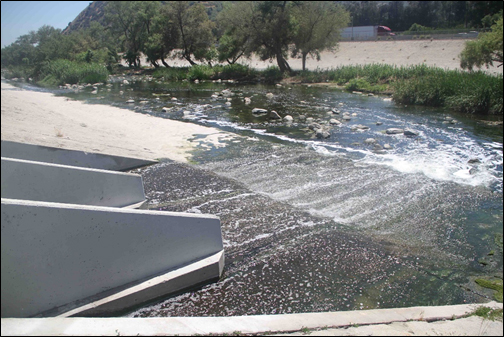Environmental flows study to determine impacts of diverting discharges from L.A. River

Water-quality managers that work in the Los Angeles River watershed have initiated a two-year study to determine the potential ecological and recreational effects of diverting treated wastewater effluent and runoff from the river for water recycling purposes.
The environmental flows study, launched in October and facilitated by SCCWRP, marks the first effort by California’s water-quality management community to understand how sensitive species, habitats and other beneficial uses will be impacted as land-based discharges to the river are reduced. Three wastewater treatment plants discharge into the effluent-dominated L.A. River.
The study is motivated by changing water use and reuse practices across drought-prone California. Under State Water Code Section 1211, California wastewater treatment agencies have been filing petitions seeking regulatory approval to begin recycling more of the effluent that they’re currently discharging into urban streams. Stormwater management agencies also are capturing more land-based runoff, further reducing stream flows.
The study will document how vulnerable species and habitats along an urban, 45-mile stretch of the lower L.A. River are expected to be impacted by multiple combinations of potential flow reductions. Researchers also will document how human recreational uses of the river, such as kayaking, will be impacted.
Additionally, researchers will consider how these impacts could potentially be offset by management interventions, such as river restoration projects and more infiltration to bolster groundwater supplies.
Study participants spent about four months conceptualizing the study, reaching agreement in October on the study’s scope. The study is a collaboration of the State and Regional Water Boards, the City and County of Los Angeles, the Sanitation Districts of Los Angeles County and SCCWRP.
Researchers plan to divide up the study area into multiple sections, then develop recommended flow targets by season for each section. Researchers also will conduct an optimization analysis to ensure recommended flow targets optimally balance the need to protect the river’s beneficial uses with the desire to capture, divert and recycle more of the river’s flows. The study will primarily rely on hydrologic computer modeling and habitat/species suitability analyses.
The study is expected to serve as a model for the State Water Board and Regional Water Quality Control Boards to evaluate stormwater management practices and 1211 wastewater change petitions filed in California. The tools developed from the study are expected to be widely applicable to similar cases involving competing demands on limited flow resources.
The study also will help inform various ongoing L.A. River planning efforts, including One Water L.A. and the L.A. River Revitalization Master Plan.
For more information, contact Dr. Eric Stein.
More news related to: Climate Change, Ecohydrology, Top News